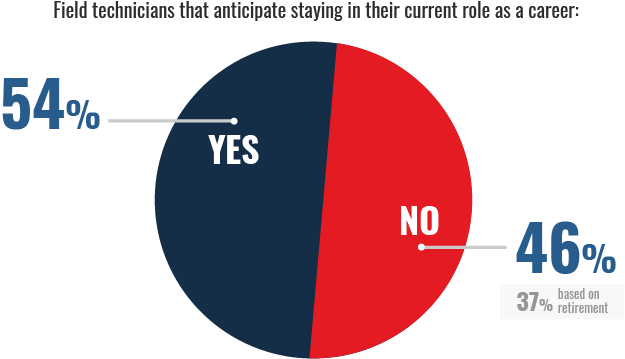
Danger Zone:
How to Address the Skilled Field Tech Shortage
In the post-COVID-19 world, recruiting and retaining skilled field service technicians is a major challenge across the industry, one which has worsened significantly during the pandemic-driven Great Resignation. So, how can field service companies ensure a healthy stable of experienced technicians to keep customers happy and the business growing?
Field services are uniquely affected by the skilled worker shortage. The accelerating pace of loss of experienced workers combined with a historic inability to attract younger, tech-savvy workers, makes for one of the greatest threats to the future of the industry.
In the past, companies combatted high staff turnover and shortages by keeping a pipeline of new technicians or engineers. The problem with this solution is that bringing on new techs on a consistent basis is costly and time-consuming, which reduces revenue and can damage customer service. Furthermore, with historically low unemployment rates and the reticence of younger workers to join the industry, there simply isn’t a large pool of quality engineers or skilled techs available. The best solution is to retain the techs you have, which will soon become a major challenge facing the industry.
A soon-to-be-released Service Council survey highlights a series of challenges for the industry. Field technicians were asked if they anticipated staying in their current role as a career. While 54% said yes, 46% said they were unsure or would not continue their field service career. “Only” 37% of those potential losses would be due to retirement. Even as there is already a struggle to keep a full plate of field techs, a potential exodus lies just around the corner. In fact, within three to four years the field service industry will likely witness 40% of field service engineers depart. So not only is it happening, but it’s also happening quickly.

Field service leaders reported the top internal challenges facing their businesses are lack of resources, workforce engagement and retention, which speaks to the deficits created by the Great Resignation and the coming wave of retirements of older technicians. As seasoned and experienced field service techs fast approach retirement age, there is a shortage of young millennials and zillennials to replace them. According to industry research, 70% of service organizations report that they will become burdened by a retiring workforce over the next five to ten years.
Another recent Service Council study reported that 50% of field service organizations are currently facing a shortage of resources to meet service demand. Combined with too many inexperienced techs in the field, these companies experience lower productivity, lower first-time fix rates, an increase in customer dissatisfaction, and loss of revenue as they pour limited resources into recruiting, training, and retaining tech talent.
Recruiting Younger Techs
A key question for the field service industry is how do you make the industry more attractive to acquire and retain top talent? Millennials and Gen Z have different expectations of the companies they work for when compared to previous generations. Younger workers want to join an industry that is innovative and utilizing the latest technology and will avoid careers that appear to be out of step with the future.
Unfortunately, there remains the perception that field service is only an old-school, roll up your sleeves, grab a wrench, blue-collar career. In reality, it is becoming much more of a high-tech, white-collar skills job, as much iPhone as Black and Decker. Until the perception matches the reality, field service companies will be forced to do more with less to ensure both a quality work experience and quality customer service. The industry must take distinct steps—upskilling, reskilling and combating false impressions—to stem the talent outflow and increase the talent inflow to create a more stable future.
Loyalty is also a problem with the younger workforce when they feel undervalued. Service leaders can attract and retain the next generation of talent by facilitating discussions between older and younger workers, providing ongoing training and education, offering flexible working arrangements, and—most importantly of all—seeking millennials’ input in planning processes.
Technology will play a leading role in meeting these challenges.
More Money…More Workers
One of the simplest ways to address tech recruiting and retention is pay. One of the biggest reasons that an employee will stay with a company is competitive pay. Over the course of the last 18 months, the average pay rate has increased and, while you may think that you cannot raise salaries any higher than you already have, pay will continue to be one the no. 1 strategic differentiator. To remain competitive on the salary front, organizations must lower other costs.
A combined field and fleet service technology solution can help unlock those savings.
For instance, if your organization is still doing business with pen and paper, the first step to cost-savings is to digitize your maintenance records and invoicing processes. When Stansfield Vending moved from manual paperwork to FieldAware, the field service software by GPS Insight, they were easily able to better manage service requests, scheduling, and dispatching, invoicing, and reporting out in the field. Stansfield noted they were able to save $40,000 on just the paper alone. They also gained tenfold on technician time spent filling out said paperwork…but more on how FSM software can help your team run more efficiently below.
On the fleet management side, one of the fastest ways to save revenue is to reduce fuel costs. Technology that monitors and tracks vehicle idling is a way to reap immediate savings. In fact, one GPS Insight customer found that 78% of their vehicle’s run time was spent idling. By using GPS fleet tracking reports and alerts, they were able to reduce excessive fuel usage by 120 gallons per month. With the savings you receive from cutting unnecessary costs, you will be able to pay more competitive salaries.
Another great cost-savings measure is to ensure vehicle usage is maximized. Increased vehicle downtime and missed services are the results of not having a preventative maintenance schedule in place. Drivers bring the vehicles in for maintenance when they can, if you’re not planning ahead of time. This leads to increased vehicle downtime either because they procrastinated on the service or multiple vehicles needed service at once.
Combined field and fleet management solutions track maintenance schedules and vehicle data such as mileage, engine hours, or by date to schedule service, ensure more efficient use and keep techs in the field. Money saved by boosting efficiency can be used to increase tech compensation or improve training.
Maximizing Efficiencies, Improving Performance
Field service companies are looking to get more out of their workforce. They’re looking for higher utilization rates, more jobs per day, and more time spent being effective, all during the normal workday. Field service software can help you manage your technicians more efficiently, saving you time and effort.
Let’s say you run a business with four two-person teams in the field. Each team returns to your office mid-day to drop off and pick up paperwork. On average, this trip takes each crew 30 minutes per day. That’s 2.5 hours per crew, and 10 hours total per week. How many more jobs could they do if they didn’t have to return to the office to the tune of 10 hours each week? Also, techs using electronic work orders with real-time syncing will save time by having everything they need to complete a job. They won’t have to call or return to the office.

In addition, technicians want to understand how they’re performing overall and against their peers. Field service management tools track these metrics and provide opportunities for rewards as well as coaching and feedback. They help identify where a technician may be struggling with a particular product line or a specific type of problem to help them improve their skills.
The right technology maximizes efficiency and improves field service effectiveness across your organization. Innovative field service management software is designed to serve as a comprehensive solution for managing field staff, job information, communications, schedules, and more in one cloud-based platform.
These solutions make organizations more efficient, ensuring that when field service professionals go to a job, they have easy access to all the tools they need to complete it. They don’t have to search and they don’t have to call somebody to have them send it. It ensures that the data is available so they can fully understand the service history, creating a frictionless experience between tech and customer.
Critically, it ensures that the right people get to the right place at the right time.
Today’s top service companies have adopted technology into their workflow, and today’s customers expect a seamless experience. Bringing mobile devices and field service management software into your business helps improve your reputation, increase your efficiency, and grow your bottom line. GPS Insight and FieldAware have changed the game by bringing together fleet and field to improve tracking and using actionable data to help businesses drive efficiency and maximize revenue during a time of great uncertainty and change.
For more information on how to transform your field service to increase revenue and your technician pool, click here.





